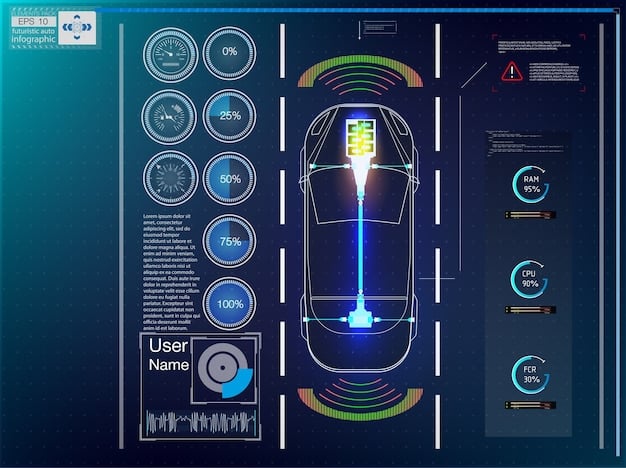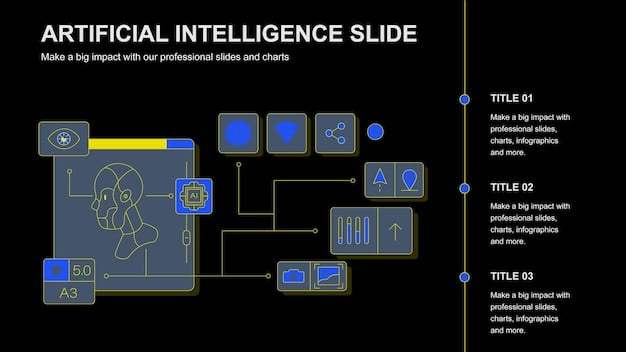Key ADAS Trends in US Vehicles: A 2024-2025 Outlook

Advanced Driver-Assistance Systems (ADAS) are rapidly evolving in US vehicles, with key trends including enhanced sensor technology, increasing integration of AI and machine learning, improved cybersecurity measures, and a growing focus on user experience and data privacy, leading to safer and more connected driving experiences.
What are the key trends in the development of Advanced Driver-Assistance Systems (ADAS) in US vehicles? The automotive landscape is rapidly transforming, with ADAS at the forefront, promising enhanced safety and convenience for drivers across the nation. As technology advances, staying informed about these trends is crucial for understanding the future of driving.
Advanced Driver-Assistance Systems (ADAS) Explained
Advanced Driver-Assistance Systems (ADAS) are a collection of electronic technologies in vehicles, designed to automate, enhance, and make driving safer. These systems utilize a range of sensors, including cameras, radar, and lidar, to perceive the vehicle’s surroundings and assist the driver in various tasks.
ADAS features range from basic functions like automatic emergency braking to more advanced systems such as adaptive cruise control and lane-keeping assist. The increasing sophistication and integration of these technologies are transforming the driving experience and paving the way for autonomous vehicles.
Key Components of ADAS
Understanding the core components of ADAS is essential for grasping its capabilities and limitations. Each component plays a crucial role in enabling the system to function effectively and provide driver assistance.
- Sensors: Cameras, radar, and lidar provide the system with data about the vehicle’s surroundings.
- Processors: These powerful computers analyze sensor data and make decisions based on pre-programmed algorithms.
- Actuators: Actuators control various vehicle systems, such as brakes, steering, and throttle, based on the processor’s commands.
- Software: The software interprets sensor data, controls actuators, and communicates with the driver through visual and auditory alerts.

Benefits of ADAS
ADAS offers numerous benefits to drivers and society as a whole. These systems have the potential to reduce accidents, improve fuel efficiency, and enhance the overall driving experience.
- Enhanced Safety: ADAS features like automatic emergency braking and lane departure warning can prevent accidents and mitigate the severity of crashes.
- Improved Convenience: Features like adaptive cruise control and parking assist make driving more convenient and less stressful.
- Reduced Fuel Consumption: Systems like eco-routing and adaptive cruise control can optimize fuel efficiency by minimizing unnecessary acceleration and braking.
In conclusion, ADAS represents a significant advancement in automotive technology, offering a range of benefits that can improve safety, convenience, and efficiency. As technology continues to evolve, ADAS is poised to play an even greater role in shaping the future of mobility.
Trend 1: Enhanced Sensor Technology
One of the most significant trends in ADAS development is the continuous improvement of sensor technology. This includes advancements in cameras, radar, and lidar systems, enabling them to perceive the environment more accurately and reliably.
These enhanced sensors provide more detailed and comprehensive data, allowing ADAS to make more informed decisions and react more effectively to potential hazards.
Improved Camera Systems
Camera systems are becoming more sophisticated, with higher resolutions, wider fields of view, and better low-light performance. These improvements enable ADAS to recognize objects and road markings more accurately, even in challenging conditions.
The development of stereo cameras, which provide depth perception, is also enhancing the capabilities of ADAS. Stereo cameras allow the system to estimate the distance to objects more accurately, improving the performance of features like automatic emergency braking.
Advancements in Radar Technology
Radar technology is also undergoing significant advancements, with higher resolutions and longer ranges. These improvements enable ADAS to detect objects at greater distances and with more precision, providing more time to react to potential hazards.
The development of 4D radar, which provides information about the object’s speed and direction, is further enhancing the capabilities of ADAS. 4D radar allows the system to predict the object’s trajectory and make more informed decisions about how to respond.
In summary, enhanced sensor technology is a crucial trend in ADAS development, enabling these systems to perceive the environment more accurately and reliably. These improvements are leading to safer and more effective driver assistance features.
Trend 2: AI and Machine Learning Integration
The increasing integration of artificial intelligence (AI) and machine learning (ML) is another key trend in ADAS development. AI and ML algorithms analyze sensor data, learn from experience, and make more human-like decisions.
This allows ADAS to adapt to changing conditions, improve its performance over time, and provide more personalized assistance to the driver.
AI-Powered Object Recognition
AI-powered object recognition systems can identify a wide range of objects, including pedestrians, cyclists, and other vehicles, with greater accuracy and reliability than traditional rule-based systems. This allows ADAS to react more effectively to potential hazards involving these vulnerable road users.
- Improved Accuracy: AI algorithms can learn to recognize objects in a variety of conditions, including different lighting, weather, and viewing angles.
- Reduced False Positives: AI systems can reduce the number of false positives, which can be annoying and distracting for the driver.
- Enhanced Performance: AI-powered object recognition systems can improve the performance of ADAS features like automatic emergency braking and pedestrian detection.
Machine Learning for Adaptive Cruise Control
Machine learning algorithms can be used to improve the performance of adaptive cruise control (ACC) systems. These algorithms can learn the driver’s preferences and adapt the ACC system’s behavior accordingly.
- Personalized Driving Experience: Machine learning can tailor the ACC system to the driver’s preferred following distance, acceleration rate, and braking style.
- Improved Fuel Efficiency: Machine learning can optimize the ACC system’s behavior to minimize unnecessary acceleration and braking, improving fuel efficiency.
- Smoother Transitions: Machine learning can smooth out the transitions between different speed settings, providing a more comfortable driving experience.

In conclusion, the integration of AI and machine learning is transforming ADAS, enabling these systems to make more intelligent decisions and provide more personalized assistance to the driver. As AI and ML technology continues to advance, ADAS is poised to become even more sophisticated and effective.
Trend 3: Enhanced Cybersecurity Measures
As ADAS becomes more interconnected and reliant on software, cybersecurity is becoming increasingly important. Protecting these systems from hacking and other cyber threats is crucial for ensuring the safety and security of vehicles and their occupants.
Automakers are implementing a range of cybersecurity measures to protect ADAS from potential attacks, including encryption, intrusion detection, and over-the-air (OTA) updates.
Encryption and Authentication
Encryption is used to protect sensitive data transmitted between different components of the ADAS system, as well as data transmitted to and from the vehicle’s cloud-based services. Authentication mechanisms are used to verify the identity of devices and users accessing the ADAS system.
These measures help prevent unauthorized access to the ADAS system and protect data from being intercepted or modified by malicious actors.
Intrusion Detection and Prevention
Intrusion detection and prevention systems (IDPS) are used to monitor the ADAS system for suspicious activity and block potential attacks. These systems can detect a variety of threats, including malware, network intrusions, and denial-of-service attacks.
IDPS systems can also be used to isolate infected components of the ADAS system and prevent the spread of malware.
In summary, enhanced cybersecurity measures are essential for protecting ADAS from hacking and other cyber threats. Automakers are implementing a range of security measures to ensure the safety and security of vehicles and their occupants.
Trend 4: Focus on User Experience
Automakers are increasingly focusing on improving the user experience of ADAS. This includes making these systems easier to use, more intuitive, and less intrusive. The goal is to provide assistance to the driver without overwhelming them or distracting them from the task of driving.
User experience improvements include more intuitive interfaces, customizable settings, and improved communication between the ADAS system and the driver.
Intuitive Interfaces
ADAS interfaces are becoming more intuitive, with clear and concise information displayed in a way that is easy for the driver to understand. This includes using graphical displays, audible alerts, and haptic feedback to communicate information about the ADAS system’s status and actions.
- Clear Visuals: Easy-to-understand icons and displays.
- Auditory Alerts: Informative and non-intrusive sounds.
- Haptic Feedback: Steering wheel or seat vibrations to alert the driver.
Customizable Settings
ADAS systems are becoming more customizable, allowing drivers to adjust the system’s settings to their preferences. This includes adjusting the sensitivity of features like lane departure warning and the following distance of adaptive cruise control.
- Adjustable Sensitivity: Tailor the system’s responsiveness to driving conditions.
- Personalized Following Distance: Set a comfortable distance behind other vehicles.
- Driver Profiles: Save preferred settings for different drivers.
In conclusion, a focus on user experience is essential for ensuring that ADAS is effective and enjoyable to use. Automakers are investing in user-centered design to create systems that are both helpful and unobtrusive.
Trend 5: Data Privacy and Ethical Considerations
As ADAS collects and processes more data, data privacy and ethical considerations are becoming increasingly important. Automakers are implementing policies and technologies to protect driver data and ensure that ADAS is used in a responsible and ethical manner.
This includes providing drivers with more control over their data, being transparent about how data is used, and addressing potential biases in AI algorithms.
Data Minimization and Anonymization
Data minimization is the practice of collecting only the data that is necessary for the ADAS system to function properly. Anonymization is the process of removing personally identifiable information from data.
These measures help protect driver privacy by reducing the amount of personal data collected and stored by the ADAS system.
Transparency and Consent
Automakers are being more transparent about how ADAS data is collected, used, and shared. They are also providing drivers with the ability to consent to the collection and use of their data.
This allows drivers to make informed decisions about whether or not to use ADAS and how their data is used.
In summary, data privacy and ethical considerations are becoming increasingly important in ADAS development. Automakers are implementing policies and technologies to protect driver data and ensure that ADAS is used in a responsible and ethical manner.
| Key Trend | Brief Description |
|---|---|
| ️ Sensor Enhancement | Improved accuracy with better cameras, radar, and lidar. |
| AI Integration | Using AI for object recognition and adaptive systems. |
| 🛡️ Cybersecurity | Protecting ADAS from cyber threats with encryption. |
| User Experience | Making ADAS easier and more intuitive to use. |
Frequently Asked Questions (FAQ)
▼
The primary goal is to enhance vehicle safety by reducing accidents, improving convenience, and providing features such as automatic emergency braking and lane keeping assist to drivers.
▼
Enhanced sensors, including cameras, radar, and lidar, provide more accurate and reliable data about the vehicle’s surroundings, enabling ADAS to make better decisions and react more effectively.
▼
AI algorithms analyze sensor data and learn from experience, allowing ADAS to adapt to changing conditions, improve its performance over time, and provide more personalized assistance to the driver.
▼
Cybersecurity is crucial because ADAS is increasingly interconnected and reliant on software, making it vulnerable to hacking and cyber threats. Protecting these systems ensures vehicle and occupant safety.
▼
Automakers are implementing policies and technologies like data minimization, anonymization, and transparency to protect driver data and ensure ADAS is used in a responsible and ethical manner.
Conclusion
The key trends in the development of Advanced Driver-Assistance Systems (ADAS) in US vehicles point towards a future where driving is safer, more convenient, and more connected. From enhanced sensors and AI integration to improved cybersecurity and user experience, these advancements are shaping the automotive landscape and paving the way for autonomous vehicles. As technology continues to evolve, it is crucial for consumers and industry professionals alike to stay informed about these trends to fully understand the benefits and implications of ADAS.





